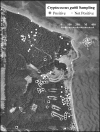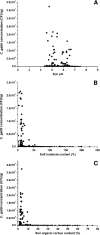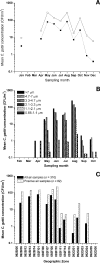Characterization of environmental sources of the human and animal pathogen Cryptococcus gattii in British Columbia, Canada, and the Pacific Northwest of the United States
- PMID: 17194837
- PMCID: PMC1828779
- DOI: 10.1128/AEM.01330-06
Characterization of environmental sources of the human and animal pathogen Cryptococcus gattii in British Columbia, Canada, and the Pacific Northwest of the United States
Abstract
Cryptococcus gattii has recently emerged as a primary pathogen of humans and wild and domesticated animals in British Columbia, particularly on Vancouver Island. C. gattii infections are typically infections of the pulmonary and/or the central nervous system, and the incidence of infection in British Columbia is currently the highest reported globally. Prior to this emergence, the environmental distribution of and the extent of colonization by C. gattii in British Columbia were unknown. We characterized the environmental sources and potential determinants of colonization in British Columbia. C. gattii was isolated from tree surfaces, soil, air, freshwater, and seawater, and no seasonal prevalence was observed. The C. gattii concentrations in air samples were significantly higher during the warm, dry summer months, although potentially infectious propagules (<3.3 microm in diameter) were present throughout the year. Positive samples were obtained from many different areas of British Columbia, and some locations were colonization "hot spots." C. gattii was generally isolated from acidic soil, and geographic differences in soil pH may influence the extent of colonization. C. gattii soil colonization also was associated with low moisture and low organic carbon contents. Most of the C. gattii isolates recovered belonged to the VGIIa genetic subtype; however, sympatric colonization by the VGIIb strain was observed at most locations. At one sampling site, VGIIa, VGIIb, VGI, and the Cryptococcus neoformans serotype AD hybrid all were coisolated. Our findings indicate extensive colonization by C. gattii within British Columbia and highlight an expansion of the ecological niche of this pathogen.
Figures






References
-
- Abegg, M. A., F. L. Cella, J. Faganello, P. Valente, A. Schrank, and M. H. Vainstein. 2006. Cryptococcus neoformans and Cryptococcus gattii isolated from the excreta of psittaciformes in a southern Brazilian zoological garden. Mycopathologia 161:83-91. - PubMed
-
- Bisby, C. R., N. James, and M. I. Timonin. 1935. Fungi isolated from soil profiles in Manitoba. Can. J. Res. 13:47-65.
-
- Boekhout, T., B. Theleen, M. Diaz, J. W. Fell, W. C. Hop, E. C. Abeln, F. Dromer, and W. Meyer. 2001. Hybrid genotypes in the pathogenic yeast Cryptococcus neoformans. Microbiology 147:891-907. - PubMed
-
- Callejas, A., N. Ordonez, M. C. Rodriguez, and E. Castaneda. 1998. First isolation of Cryptococcus neoformans var. gattii, serotype C, from the environment in Colombia. Med. Mycol. 36:341-344. - PubMed
Publication types
MeSH terms
LinkOut - more resources
Full Text Sources

